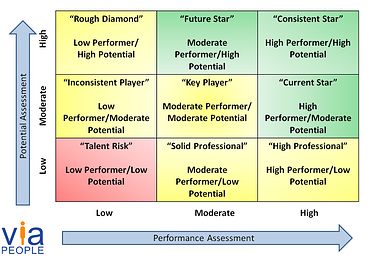As succession planning processes become more common in organizations today, HR teams are using a popular method for identifying and classifying talent: The 9 box chart. The 9 box chart is a matrix that contains employees categorized by two variables: their performance ranking and their potential for advancement.
 Here is an example of a typical 9 box chart. More often than not, there are 3 categories for performance and 3 categories for potential. However, depending on your specific needs this could also become a 12 box, 15 box, or whatever best meets the needs of your business.
Here is an example of a typical 9 box chart. More often than not, there are 3 categories for performance and 3 categories for potential. However, depending on your specific needs this could also become a 12 box, 15 box, or whatever best meets the needs of your business.
→ Want more succession planning insights delivered straight to your inbox? Subscribe to our blog.
From here the process can vary considerably depending on the organization’s culture and experience with succession planning. In many organizations, this chart is provided to leaders so they can “slot” their managers into each cell and then make decisions from the data or bring their charts to a broader leadership discussion to gain consensus. In my experience, I have found that there are significant problems with this approach and the main issue is the lack of objectivity in categorizing employees.
Why You Need to Back Up 9 Box Ratings with Data
Manager ratings are unfortunately subject to biases, such as:
- Rating biases such as leniency are frequently found in manager ratings
- Managers each rely on their own standards when rating others and these often differ from manager to manager
- Different levels of exposure exist between managers and their employees and this can also affect the type of rating provided
Making promotion decisions that are solely dependent on 9 box ratings could be problematic.
Without some type of objective assessment data, significant promotion decisions may be made on very limited and biased information. For this reason, I strongly encourage clients to conduct some type of talent assessment, ideally using technology so they can include a multitude of variables, before deciding on an individual’s performance or potential.
Some of the following recommendations help to ensure not only a complete 9 box chart but most importantly, an accurate one.
For the Performance Dimension:
- Include several years of past performance evaluation data (3, ideally)
- Add competency ratings for the leader’s respective level
- Consider including 360 assessment data to round out the performance of each leader
For the Potential Dimension:
- First, gain consensus within the leadership team on how high-potential should be defined
- What are the attributes that differentiate someone with high, medium and low potential?
- Often high-potential individuals are considered more emotionally mature and have stronger strategic thinking skills than others. These variables can be emphasized in your competency assessment
- Consider objective, psychologically-validated assessments
Like any HR initiative, the better the data, the more quality results you should expect. With succession planning this is not only important but imperative. Not only are leadership careers influenced by these decisions but the overall success of the organization.
Get Started with 9 Box Ratings
Ready to try using the 9 box in your own succession planning process? We designed a 9 box toolkit to help you get started. Download it to get a template and guide to using the 9 box for succession planning today!
